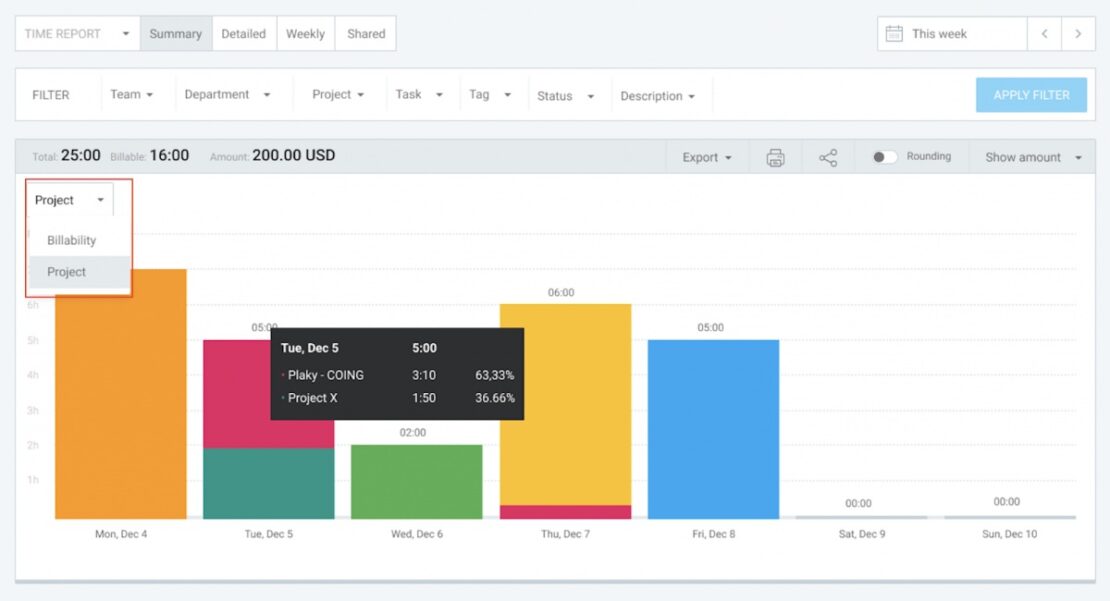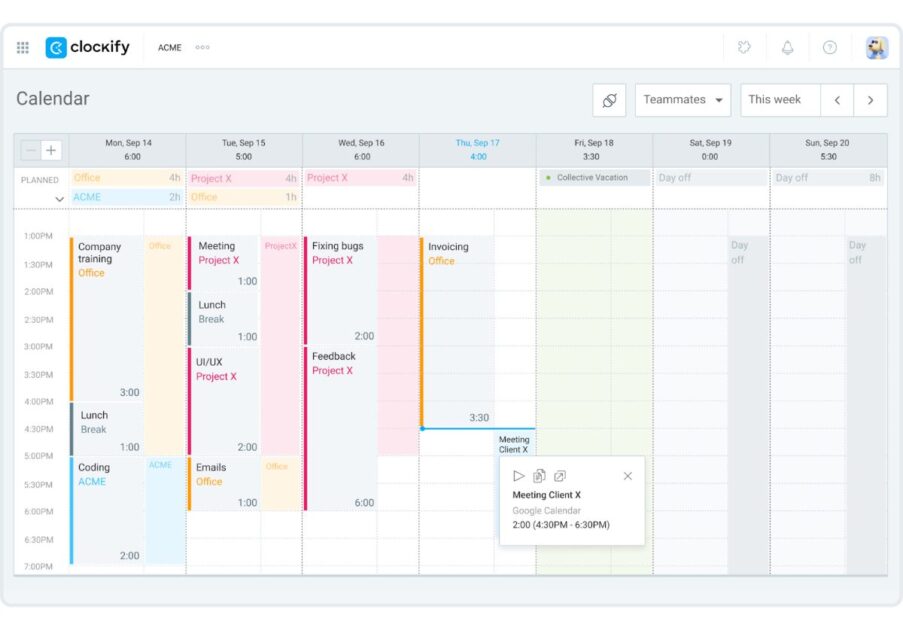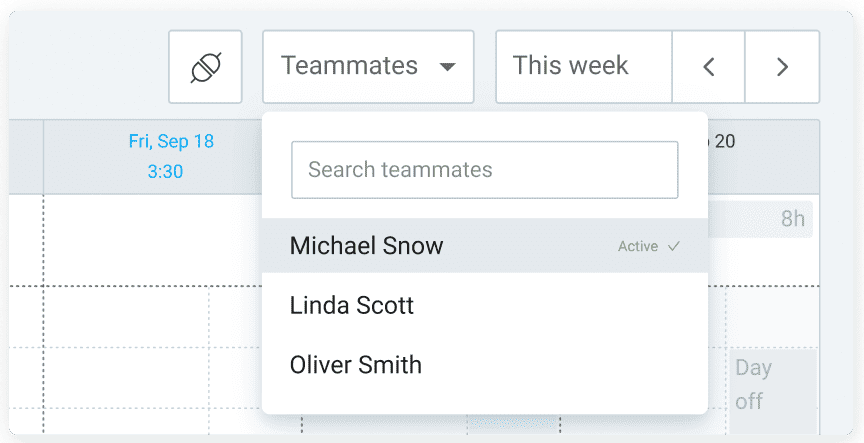If you’re like most managers, you must be sick and tired of missed deadlines and wasted hours.
But fear not.
Time management is a set of principles and tools that help you use your time more effectively.
Therefore, effective employee time management is crucial for enhancing your team’s efficiency and productivity.
Let’s see how you can improve the time management skills of both you and your employees.

How to improve employees’ time management
Time management is a skill like any other, which means your employees can learn and improve over time.
Here are a few tried-and-tested ways you can help them as a manager or business owner.
Method #1: Time management training group activities
Managers can organize time management training for their employees through various group activities, such as:
- Workshops, and
- Team events.
These activities will enhance communication between colleagues, leading to more productive teamwork as well.
Enhance your time management now
Method #2: On-the-job training
This is the type of time management training that happens during work hours. A team lead or a manager is responsible for leading the training. The most essential topics that should be covered during the training are:
- Setting goals,
- Learning how to prioritize, and
- Organizing a workday according to employees’ daily responsibilities.
Track your workday with Clockify
Method #3: Online time management courses
This is a perfect option for employees who are already too busy during their working hours. With online courses, each employee can choose when they attend the time management training throughout the week.
In the next section, we’ll show you what each of us can do to be better at time planning.
💡 CLOCKIFY PRO TIP
Need help with your own time management? Here’s a comprehensive guide to get you started:
How can you improve your time management at work?
Regardless of your position at the company, there are simple ways to improve your time management skills. Here are a few suggestions to get you on the right track.
Method #1: Track your time
By monitoring your working hours, you’ll know what takes the most time. With that information, you’ll be able to prioritize tasks and organize your time better.
However, it’s important to track time efficiently. If you jot down your tasks and hours manually, this becomes a whole new task — ultimately wasting more time than you’ll save.
Instead, use a simple employee time tracking tool like Clockify.

With Clockify, you and your employees can use a simple start-stop timer to record what you’re working on and for how long.
The app will automatically fill your timesheets with this information as you use the timer, but you can also enter the data yourself and edit timesheets manually.

Based on your time entries, Clockify automatically generates visual reports in real-time. That way, you always know how much time tasks take and what to prioritize.
Here’s how Clockify breaks down your time in the summary report, with clear, color-coded graphs:

With such a detailed view of your workday or workweek, you can make more accurate project estimates and schedules.
💡 CLOCKIFY PRO TIP
Struggling to make time estimates on your projects? Take a look at our detailed guide for time estimation in project management:
Method #2: Find your productive hours
We can’t expect to be productive all day long. We all have a biological prime time for productivity, and our energy levels fluctuate throughout the day in accordance with our circadian rhythm.
So, how does the circadian rhythm work for most people?
After waking up, you need a few hours to reach your peak levels of energy. This usually happens in the afternoon. But those levels start to decrease afterward, reaching their lowest point around 3 pm. That’s why you sometimes feel tired after lunch.
The good thing is that you become more alert again in the late afternoon, with a second peak around 6 pm. Then, your energy levels decline during the evening and night, hitting their lowest point at around 3:30 am. However, your alertness starts increasing again in the morning, until it reaches the first peak around noon the next day.
Still, circadian rhythms can vary. Based on when they’re most productive, people can be:
- Larks — morning people who reach peak energy levels earlier than the average person, and
- Owls — night people who reach peak energy levels much later than the average person.
Working according to your circadian rhythm is crucial for optimal performance, productivity at work, and effective time management. Try to leave less important tasks for periods when you have less energy during the day.
Organize your time with Clockify
Method #3: Use time management apps
To make the most of your (and your team’s) time at work, consider using some of the best time management apps, like Clockify.
You can use Clockify’s built-in calendar to organize your work time better.

Next to each calendar entry, you can see your actual tracked time for that period.
For example, if you make a 30-minute calendar entry for a task and it takes an hour, you will see this difference on the calendar. As a result, you can compare your estimates to actual performance and make more realistic projections in the future.
As a manager, you can see and edit each employee’s calendar by selecting them from the Teammates menu above the calendar.

As a result, you’ll always have a clear overview of how each employee spends their time — and how they measure up to project estimates.
Make accurate estimates with Clockify
Method #4: Don’t skip your breaks
Even on busy days, try to take several quick breaks throughout the day. If you skip your breaks, you’ll be more tired and unable to complete demanding tasks.
Conversely, taking regular breaks will make you more productive and ready to handle your workload.
Another handy time management tip — use the Pomodoro technique to take regular breaks. This is how the Pomodoro method works:
- Split your workload into 25-minute work sessions — each of these sessions is called a Pomodoro,
- After 25 minutes, take a 5-minute break, and
- Once you’ve finished 4 cycles, take a longer break of 20 minutes.
By following this simple rule, you’ll be more focused on work during your working sessions, and you’ll be able to unwind during your breaks.
💡 CLOCKIFY PRO TIP
Need help getting rid of workplace habits that make you less productive? Check out our guide on eliminating bad habits with time tracking:
How to motivate people to track time
Employees often resist time tracking because it requires effort and makes them feel uneasy.
Sometimes, these are legitimate concerns. If you track time inefficiently, the effort it takes may, ironically, lower productivity. Also, people often feel pressured, thinking that management will judge them for every break and project that takes too long to complete.
Let’s examine a few ways managers can dispel these concerns.
Method #1: Explain why you need time tracking
Start by appealing to people’s rational side. They need to understand why time tracking is important for the company, like:
- Accurate billing for clients when you charge by the hour,
- Precise payroll calculation for employees on an hourly wage,
- Compliance with applicable laws when working on government contracts or other projects that require logging hours, and
- Profitability estimates that show which projects and clients are worth their hourly rates.
Method #2: Give emotional reassurance
People need to understand that you’re not looking to monitor anyone’s personal data or non-work activities.
Communicate to your team that time tracking is not about spying on people, controlling who spends too much time on breaks, or setting unrealistic goals. It’s simply about seeing where the time goes and spending less of it on non-profitable projects.
The last thing you want is to make people feel bad.
To establish trust, show you trust your employees first. Let people decide if they want to track time using a timer or enter hours manually at the end of the day. By letting people self-report their work hours, you put them in control. By giving people control, you remove the anxiety and distrust.
Method #3: Make it super easy and convenient
The easier it is to track time, the more employees will do it.
To make it more convenient, let people track time from wherever — their phone, desktop computer, browser, or within other apps.
If someone forgot to start a timer, let them log the time after the fact. In fact, you can set up an automatic reminder to send a friendly notification to remind them to log their missing hours.
The important thing is to keep your requirements minimal. You don’t need a 1,000-word essay on everything someone did in a day, or an overlong log listing every time they opened a new browser tab. In most cases, that’s not data you’d even use — and employees will appreciate it.
Finally, have clear guidelines for how everyone should track time and what their time logs should look like. Eliminating confusion and getting all employees on the same page will make time tracking easier for everyone.
Method #4: Make time data transparent
Unless you’re working on confidential projects, sharing time data is a great way to build trust and motivate people to track time.
You can let everyone see how many hours their colleagues have logged via Clockify’s team dashboard — in real time. Plus, they can see which projects and tasks everyone is working on.
By having an open, transparent, and fair process, you’ll gain trust and goodwill that are crucial to adoption.
Master employee time management with Clockify
Learning how to manage your time at work is essential for your overall performance and productivity, and the same goes for your employees.
A reliable tool like Clockify helps you consistently improve your time management with:
- Simple ways to track time without increasing your workload,
- Powerful visual reports with valuable insights in real time, and
- Built-in calendar that helps you compare performance and estimates.

On the team dashboard, you can see a breakdown of what everyone in your team is doing, including the total amount of tracked time, projects, and individual tasks. As a result, you’ll always know how well your employees are managing their time.
Stop relying on hunches, gut feelings, and inefficient time tracking methods.
Instead, Clockify gives you accurate data that actually shows how your team spends their time. Don’t miss your opportunity to be more effective.



